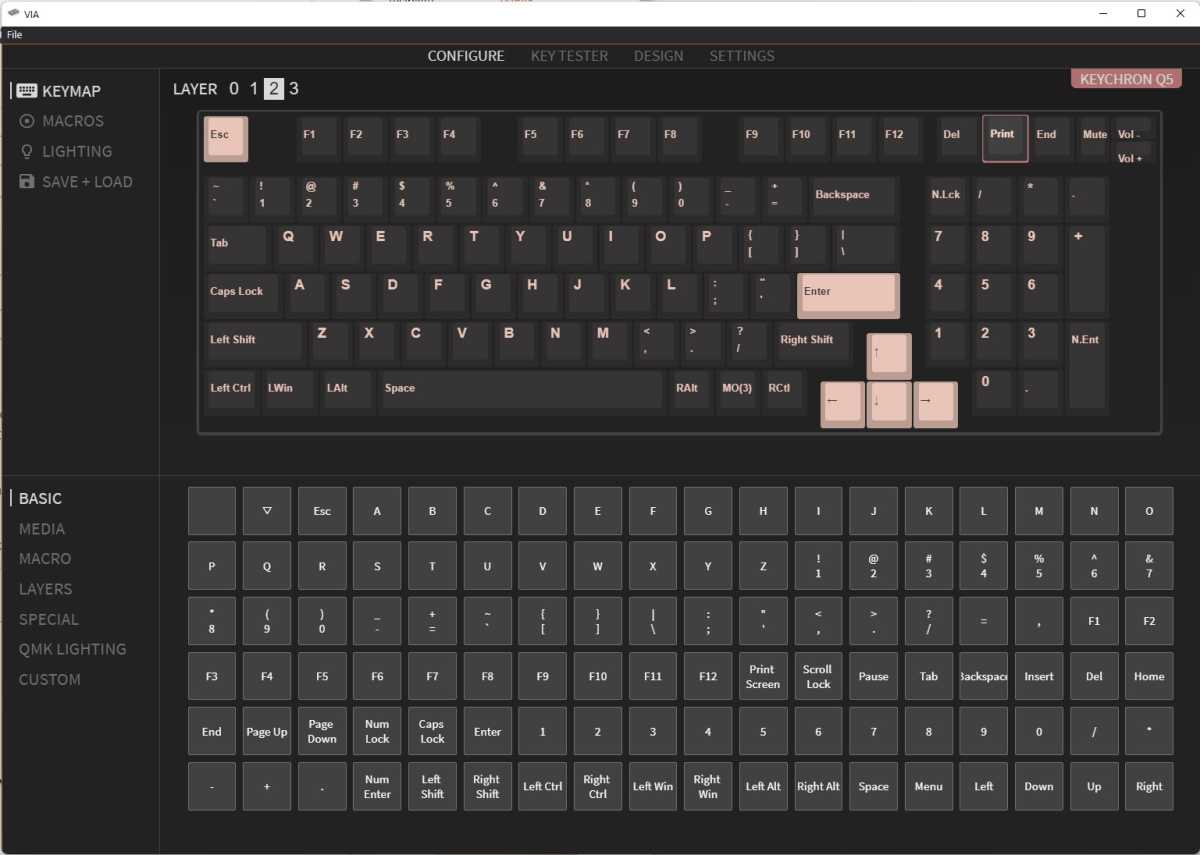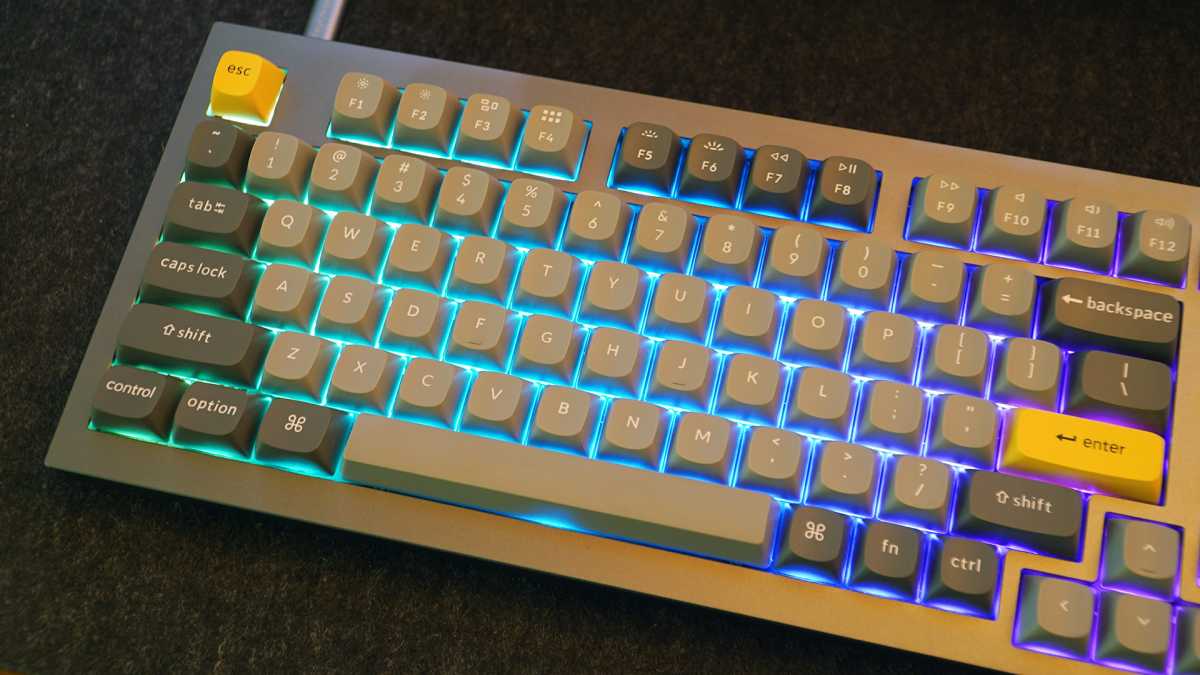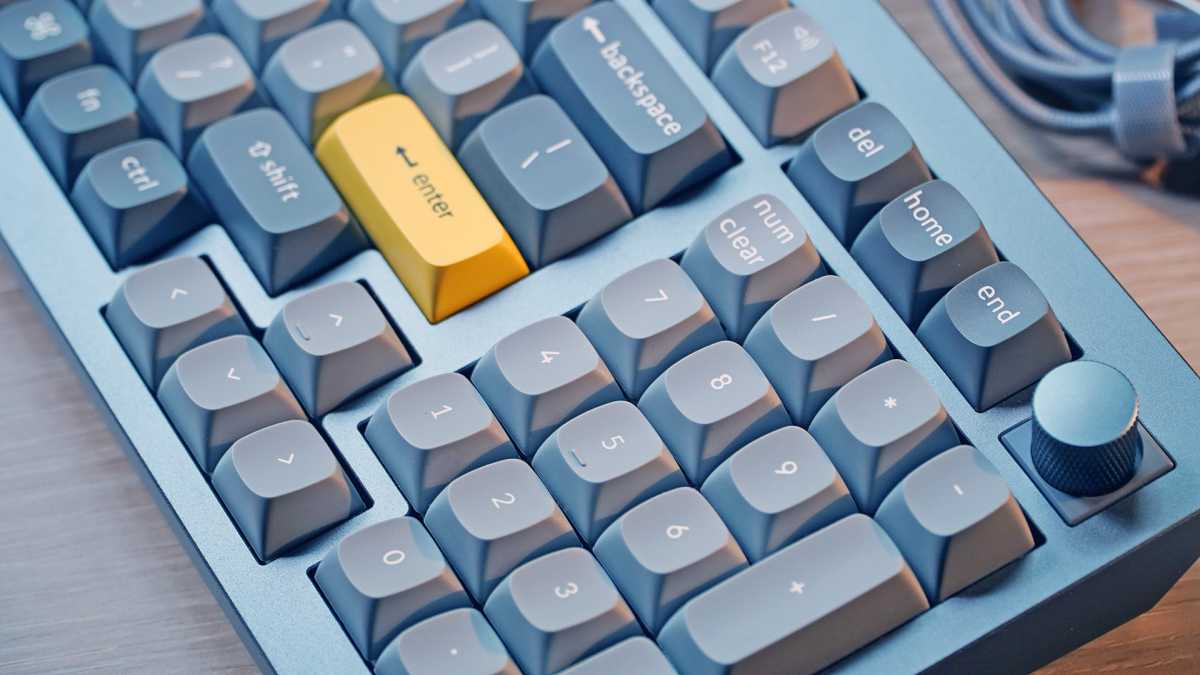 At a glance
At a glanceExpert's Rating
Pros
- Super-heavy body
- Great keycaps
- Excellent customization
- Surprisingly competitive price
Cons
- Unnecessary Mac/Windows switch
- Programming layer limits
- No adjustable feet
Our Verdict
The Keychron Q5 is a great value, which is a strange thing to say about a $200 keyboard. But its packs excellent typing feel, parts, and customization at a price that’s about half as much as the customized designs it’s based on.
Spend some time on a mechanical keyboard forum or subreddit, and you’ll see custom designs that people spent hundreds of hours on, and which cost more than the average car payment. And they’re absolutely amazing, practically works of art that just happen to have a bunch of switches and USB port. They’re the kind of covetous objects that nerds dream of for years.
Keychron’s Q series of keyboards can’t reach the lofty heights of these custom designs. But they can get damn close, and do so at a fraction of the cost. And here’s the kicker: You can order them at any time without waiting a year or more for an artisan small batch to arrive.
Such is the case with the Keychron Q5, which features a smart layout, just about every premium feature you can imagine, and a price that’s a bit of a splurge instead of something you have to fool yourself into calling an “investment.” It’s a massive slab of lovingly-carved aluminum, and though it isn’t perfect, it’s acceptably imperfect for anyone looking for a premium keyboard experience.
All the features
If I wrote out the features of the Q5 in standard prose I’d be here all day. Suffice it to say it has almost every single function of a $500 custom mechanical keyboard build, at less than half the price. But there are a few parts that need to be highlighted if you’re considering a purchase.
First and most notably, the case. Picking up this behemoth almost requires a spotter. It’s 82 ounces on my kitchen scale, including switches and keycaps—heavier than most laptops on the market. That’s because the case is two slabs of thick milled aluminum, plus a heavy steel plate sitting on the PCB. It is, in a word, a beast.

Michael Crider/IDG
And yet strangely, the layout is designed to make it small, or at least a bit smaller than the even more enormous Q6 and its standard 108-key layout. The Keychron Q5 scrunches the arrow cluster in between the main typing area and the 10-key in a layout known as “1800,” inherited from some Cherry designs in the ’90s. This means that you save about 2.5 inches of width versus a full layout, losing only the page up, page down, and insert keys, with a few non-standard keycap sizes like the right shift and num pad zero. Also note the inclusion of a rotary dial in the upper-left corner, a premium add-on that can be programmed like the rest of the case.
The imposing size and weight of the Q5 is only half of the appeal. Actually sit down to type, and you’ll be amazed at the feeling of quality that simply oozes off of the board. How does it feel so good? There are a lot of individual components contributing to that wonderfully “thocky” typing, so like Mrs. Browning, let me count the ways:
- Gasket mount — first and foremost is the gasket system, which essentially suspends the steel plate and the circuit board between two layers of foam. This lets the keys have a slight give and “bounce” to them, as opposed to a more definitive “thunk” that you’ll find on other mechanical keyboards, where your finger strokes can travel right down to the case itself.
- Case foam — in addition to the gasket pieces, the Q5 includes two levels of foam insulation, one between the plate and the PCB, and another beneath the PCB and the case. This helps avoid the “ping” that you get in some other keyboards as the springs in the switches reverberate on other metal parts, and reduces noise in general.
- Switches — speaking of switches, these come from Gateron. But they’re not your ordinary MX clones: Keychron sprang for G Pro switches, which come pre-lubed with gold alloy contacts pins for a smooth feel and a long lifespan. In layman’s terms, they’re the good stuff. Keychron gives you a choice of linear Reds (included in our review unit), clicky Blues, or tactile Browns.
- Keycaps — the last piece of the puzzle, and the one your fingers interact with directly. Keychron didn’t skimp here, either: The Q5 comes with a set of doubleshot PBT caps in the classic (and very tall) OSA profile. These are extremely high-quality, though they’ll take some getting used to if you’re coming from a more conventional keyboard or laptop.
Whew, that’s a lot of stuff! On top of all that, the Q5 uses a USB-C cable at the top-right, comes with a dedicated switch for Windows and Mac layouts, and includes the optional rotary dial. The dial defaults to volume controls, and you can press down for one more button (mute). While the keyboard isn’t marketed at gamers, its extensive programming tools and 1000Hz polling rate means it’ll work fine in just about any PC game, especially with red switches.

Michael Crider/IDG
Inside the box you’ll find a keycap puller, key switch puller, a braided USB-C-to-C cable with an A adapter, plus a screwdriver and hex key if you feel like taking this monster apart.
Speaking of which…
Endless customization with a programming quirk
Almost every aspect of the Keychron Q5 is designed to be customized. It has the now semi-standard hot-swappable PCB, so if you’re not a fan of the Gateron G Pros, you can fit in any MX-style switch you want. That’s also true of the stabilizers, the extra pieces that let keep long keycaps from wobbling—the ones on the board are excellent and generously lubed, but they’re screw-in and can be removed and replaced.
Other aspects of the board can be customized as well. If for some reason you want it to be louder, you can open it up and remove the case foam, or add in a little extra (it comes in the box along with spare screws and plastic feet). And of course, the PCB has individual RGB LEDs that can be reprogrammed for various layouts and patterns.

Michael Crider/IDG
Keychron has included programming for this board via popular open-source tool QMK and the much more user-friendly VIA. At first programming the Q5 was driving me crazy, as VIA recognized it but none of the changes I made seemed to be applied. Then I pored over the documentation and saw what I’d missed the first (several) times I read it: The layers are split between that Mac/Windows switch that’s been a staple of Keychron keyboard designs for years.
So when programming the Q5, layer 00 (typically the main typing layer) and 01 are the Mac layers, while layers 02 and 03 are the Windows layers. Switch over to Windows mode and Layer 2 becomes your new layer 0. This is confusing—why have dedicated Mac and Windows modes in a reprogrammable keyboard at all?—and a bit limiting, since you’re now stuck with just two layers of programming per mode.

Michael Crider/IDG
But frankly, that’s a small nitpick. Once I got over the initial Mac/Windows switch confusion, I was able to use Via to do everything I needed to for programming…which wasn’t much on a board this size.
Two other notes for customization: The somewhat rare 1800 key layout means you’ll need to hunt for a 1.75-width Shift key and a 1x numpad 0 to match any theme. That’s not so hard for a lot of custom sets, and easy enough to fake with others. The only other issue I had is that the keyboard has no option for feet. It’s a thick case with a shallow angle, and if you want it to be higher you’ll need to prop it up on something—I used a couple of Coke bottle caps, but I’d probably add these thick suckers if I was going to use the Q5 full-time.
Surprising value
The Q5 costs $205 in the configuration Keychron sent us, with the upgraded radial dial. It’s also available in anodized black and navy blue, with gorgeous OSA keycaps to match, and your choice of Gateron Pro switches. “Barebone” versions without switches or keycaps are as little as $175, but frankly, that’s not a good deal considering how nice both of those parts are.

Michael Crider/IDG
$205 is a hell of a lot to spend on a keyboard. (Yes, Razer, Logitech, Corsair, it is, and you won’t get me to say otherwise.) But compared to the small batch, super-custom designs that Keychron swiped most of these features from, it’s actually about half of what you’d expect to pay. (And you don’t have to wait a year and a half to get it delivered.) It’s even less than the Drop SHIFT, a similar mass-produced premium board—but which lacks the rotary dial and gasket mount, and has a much less substantial case.
The Q5 and its sister designs are, in short, a pretty great value if you’re looking for a high-quality board in the style of high-quality customs. And with everything included that you need to start customizing on your own, they’re also surprisingly good for newcomers who want to jump into the deep end of the mechanical keyboard pool. Just be wary: The Keychron’s custom series might spoil you for more affordable boards.

Michael Crider/IDG
The same set of features are available in full size (Q6), tenkeyless (Q3), 60% (Q4), 65% (Q2), 75% (Q1), and the new Alice layout (Q8), at prices that are similarly reasonable.
Conclusion
While there are some questionable programming restrictions, and I wish the body design had optional feet for a more dramatic typing angle, the Keychron Q5 is otherwise nearly flawless as a high-quality board with great options for customization. With a surprisingly good price point, it dominates this highly specialized market in just about every way.


